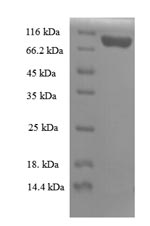Inserting the gene encoding the Mouse Kpnb1 protein (1-876aa) into a plasmid vector results in the creation of recombinant plasmid, which is introduced into e.coli cells. e.coli cells that can survive in the presence of a specific antibiotic are selected, indicating successful uptake of the recombinant plasmid. The e.coli cells containing the recombinant plasmid are cultured under conditions promoting the expression of the gene of interest. A N-terminal 6xHis tag is linked to the protein. After expression, affinity purification is used to isolate and purify the recombinant Mouse Kpnb1 protein from the cell lysate. Denaturing SDS-PAGE is then applied to resolve the resulting recombinant Mouse Kpnb1 protein, revealing a purity level exceeding 90%.




